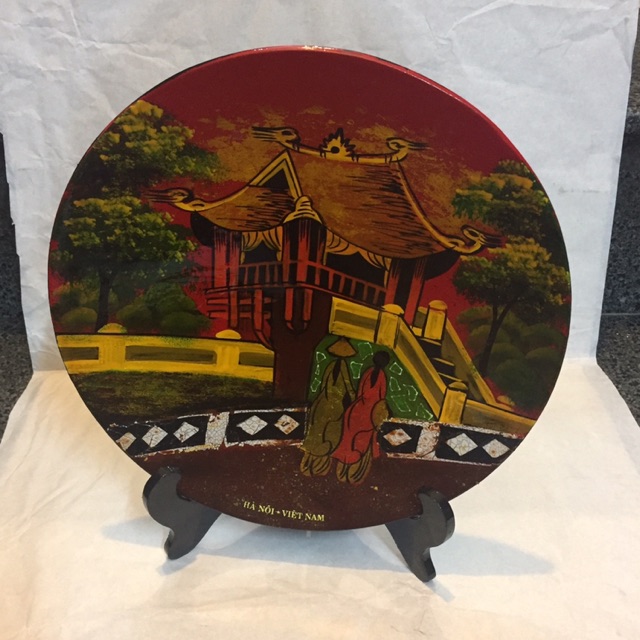Guazuma ulmifolia
| Guazuma ulmifolia | |
|---|---|
| Phân loại khoa học | |
| Giới (regnum) | Plantae |
| (không phân hạng) | Angiospermae |
| (không phân hạng) | Eudicots |
| (không phân hạng) | Rosids |
| Bộ (ordo) | Malvales |
| Họ (familia) | Malvaceae |
| Chi (genus) | Guazuma |
| Loài (species) | G. ulmifolia |
| Danh pháp hai phần | |
| Guazuma ulmifolia Lam., 1789 | |
Guazuma ulmifolia là một loài thực vật có hoa trong họ Cẩm quỳ. Loài này được Lam. mô tả khoa học đầu tiên năm 1789.[1]
Chú thích
[sửa | sửa mã nguồn]- ^ The Plant List (2010). “Guazuma ulmifolia”. Truy cập ngày 4 tháng 6 năm 2013.
Liên kết ngoài
[sửa | sửa mã nguồn]Thục địa
Thục địa - Guazuma ulmifolia Lam. var. tomentosa K. Schum., thuộc họ Trôm - Sterculiaceae.
Mô tả: Cây gỗ lớn trung bình, trông giống như cây Cò ke; nhánh non có lông mịn. Lá xoan bầu dục, gốc hình tim, gân gốc 3-5, hơi nhám vì có lông mịn; lá kèm 4mm. Cụm hoa ngắn ở nách lá, hoa màu vàng tươi, đài có lông sát; cánh hoa 5, cong, tận cùng bằng một phần phụ cao, chẻ hai, màu nâu; nhị lép nhọn. Quả xoan, có u nâu, đen.
Ra hoa tháng 5-12.
MUTAMBA (Guazuma ulmifolia)
Family: Sterculiaceae
Genus: Guazuma
Species: ulmifolia
Synonyms: Bubroma guazuma, Diuroglossum rufescens, Theobroma guazuma, Guazuma coriacea, G. inuira, G. polybotra G. tomentosa, G. utilis
Common Names: Mutamba, mutambo, embira, embiru, West Indian elm, guazima, guacima, guacimo, guasima de caballo, aquiche, ajya, guasima, cimarrona, guazuma, bolaina, atadijo, ibixuma, cambá-acã, bay cedar, bois d’homme, bois d’orme, bois de hetre, orme d’Amerique
Price: £22.50 – 1 lb / 454 gm Bag
Parts Used: Bark, leaves, root
From The Healing Power of Rainforest Herbs:
| MUTAMBA | ||
| HERBAL PROPERTIES AND ACTIONS | ||
| Main Actions | Other Actions | Standard Dosage |
| kills bacteria | reduces inflammation | Bark |
| kills fungi | prevents ulcers | Infusion: 1 cup 1-3 |
| kills viruses | supports heart | times daily |
| kills cancer cells | stimulates digestion | Capsules: 2 g twice daily |
| cleanses blood | protects liver | Tincture: 2-3 ml twice daily |
| suppresses coughs | reduces fever | |
| fights free radicals | promotes perspiration | |
| lowers blood pressure | ||
| relaxes muscles | ||
| stops bleeding | ||
| heals wounds | ||
Mutamba is a medium-sized tree that grows up to 20 m high, with a trunk 30 to 60 cm in diameter. Its oblong leaves are 6 to 12 cm long, and the tree produces small white-to-light-yellow flowers. It produces an edible fruit that is covered with rough barbs and has a strong honey scent. Mutamba is indigenous to tropical America on both continents and found throughout the Amazon rainforest.
TRIBAL AND HERBAL MEDICINE USES
Mutamba is called guasima or guacima in Mexico, where it has a very long history of indigenous use. The Mixe Indians in the lowlands of Mexico use a decoction of dried bark and fruit to treat diarrhea, hemorrhages and uterine pain. The Huastec Mayans of northeastern Mexico employ the fresh bark boiled in water to aid in childbirth, for gastrointestinal pain, asthma, diarrhea and dysentery, wounds, and fevers. Mayan healers in Guatemala boil the bark into a decoction to treat stomach inflammation and regular stomachaches. Mutamba was a magical plant to the ancient Mayans who also used it against “magical illnesses” and evil spells. In the Amazon, indigenous people have long used mutamba for asthma, bronchitis, diarrhea, kidney problems, and syphilis. They use a bark decoction topically for baldness, leprosy, dematosis and other skin conditions.
Mutamba holds a place in herbal medicine systems in many tropical countries; chiefly the bark and leaves are used. In Belizean herbal medicine practices, a small handful of chopped bark is boiled for 10 minutes in 3 cups of water and drunk for dysentery and diarrhea, for prostate problems, and as a uterine stimulant to aid in childbirth. A slightly stronger decoction is used externally for skin sores, infections, and rashes. In Brazilian herbal medicine practices, a bark decoction is used to promote perspiration, cleanse and detoxify the blood, and to suppress coughs. There it is used for fevers, coughs, bronchitis, asthma, pneumonia, syphilis, and liver problems. A bark decoction is also prepared and is used topically to promote hair growth, to combat parasites of the scalp, and to treat various skin conditions. In Peru, the dried bark and/or dried leaves are made into tea (standard infusion) and used for kidney disease, liver disease, and dysentery. There the bark is also used topically for hair loss. In Guatemala, the dried leaves of the tree are brewed into a tea and drunk for fevers, kidney disease, and skin diseases, as well as used externally for wounds, sores, bruises, dermatitis, skin eruptions and irritations, and erysipelas.
PLANT CHEMICALS
Mutamba bark is a rich source of tannins and antioxidant chemicals called proanthocyanidins. One in particular, procyanidin B-2, helps validate mutamba’s long standing use in several countries for hair loss and baldness. In 1999, researchers in Japan reported that procyanidin B-2 was a safe topical hair-growing agent. From 2000 to 2002, they published three in vitro and in vivo (in balding men) studies showing that procyanidin B-2 promoted hair cell growth and increased the total number of hairs on a designated scalp area. Researchers have determined that mutamba bark is a rich source of this natural chemical compound. Other independent research indicates that procyanidin B-2 also has antitumorous and anticancerous effects (even against melanoma) as well as lowers blood pressure and protects the kidneys. The bark also contains a chemical called kaurenoic acid which has been documented with antibacterial and antifungal properties in many studies over the years. The leaves of mutamba contain caffeine, however none has been found in the bark of the tree.
Mutamba’s main plant chemicals include: caryophyllene, catechins, farnesol, friedelin, kaurenoic acid, precocene I, procyanidin B-2, procyanidin B-5, procyanidin C-1, and sitosterol.
BIOLOGICAL ACTIVITIES AND CLINICAL RESEARCH
Mutamba’s long history of effective uses in herbal medicine propelled researchers to begin studying its properties and activities in the laboratory (beginning in 1968). It has been the subject of numerous studies since. In the first study published, using various animals (rats, rabbits, guinea pigs, cats and insects), reported that it lowered heart rate and blood pressure, relaxed smooth muscles and stimulated the uterus. Two years later, another researcher reconfirmed the uterine stimulant effects in rats, validating its historical uses as a uterine stimulant and childbirth aid. In eight different studies from 1987 to 2003, various leaf and bark extracts have clinically demonstrated remarkable antibacterial activity in vitro against several disease-causing pathogens, including Bacillus, Staphylococcus, Streptococcus, E. coli, and Neisseria gonorrhea. One of the recent 2003 studies also confirmed its antioxidant effects. In a 1995 in vitro study, mutamba also demonstrated antiviral activity against Herpes simplex type 1.
These studies could certainly explain why mutamba has been used so effectively in herbal medicine systems for many types of gastrointestinal problems, such venereal diseases as gonorrhea and syphilis, and upper respiratory conditions (pneumonia and bronchitis). Subsequent research focusing on particular chemicals found in mutamba documented their ability to interfere with an enzyme process by which bacteria and pathogens replicate. Scientists showed that these chemicals interacted with a cholera toxin-preventing its toxicity and the resultant diarrhea.
Traditionally a decoction of mutamba leaves has been used in Mexico for diabetes. It has only been recently (in 1998) that researchers in Mexico validated this indigenous use, publishing a study showing that a leaf extract significantly decreased hyperglycemia in rabbits. Of particular note (in 1990), a Brazilian research group demonstrated that a crude extract of mutamba bark was toxic to cancer cells in vitro, exhibiting a 97.3% inhibition rate. In yet another recent study (in 2002), Belgium researchers reported the possible mechanism by which mutamba bark reduces hypertension – it inhibits an enzyme called angiotensin II. Angiotensin inhibitors represent a newer classification of heart drugs (newer than the ACE-inhibitors) which are now being prescribed to lower blood pressure.
CURRENT PRACTICAL USES
Research continues to document the unique properties and actions of this plant while validating its traditional uses. Mutamba is a favorite natural remedy among Central and South American health practitioners and the indigenous peoples of the Amazon. It is often turned to first for upper respiratory infections as it can quiet coughs, reduce fever, as well as provides antiviral and antibacterial actions. It will be interesting to see if anyone in North or South America follows up on the research concerning hair loss and utilizes mutamba as a natural product for baldness and hair loss prevention. There certainly is a ready (and very profitable) market for products such as these. . . especially if they are effective!
| Main Preparation Method: decoctionMain Actions (in order):
antibacterial, antiviral, antifungal, antioxidant, hypotensive (lowers blood pressure) Main Uses: -as a topical hair remedy for hair loss and baldness -as a digestive aid for stomachache, diarrhea, dysentery, and stomach inflammation -as an external skin remedy for wounds, rashes, skin parasites, dermatitis, fungal infections and leprosy -for viral and bacterial infections (including syphilis, gonorrhea, upper respiratory viruses, and kidney infections) -as an astringent to stop bleeding Properties/Actions Documented by Research: ACE-inhibitor (typically lowers blood pressure), antibacterial, anticancerous, antifungal, antioxidant, antispasmodic, antitumorous, antiviral, cardiac depressant, cardiotonic (tones, balances, strengthens the heart), hypoglycemic, hypotensive (lowers blood pressure), muscle relaxant, uterine stimulantOther Properties/Actions Documented by Traditional Use: anti-inflammatory, antihemorrhagic (reduces bleeding), cough suppressant, antiulcerous, astringent, blood cleanser, cough suppressant, decongestant, diaphoretic (promotes sweating), digestive stimulant, emollient, febrifuge (reduces fever), hepatoprotective (liver protector), hepatotonic (tones, balances, strengthens the liver), wound healer Cautions: Use with caution and under doctor supervision if you have a heart condition.
|
Traditional Preparation: The traditional remedy for upper respiratory infections, asthma and other respiratory problems is one cup of a standard bark decoction 2-3 times daily. For gastrointestinal problems and other conditions the same bark decoction is used or 2-3 ml of a 4:1 tincture twice daily or one to 2 grams of powdered bark daily in tablets or capsules or stirred into water or juice can be substituted if desired. The same bark decoction is rinsed through the hair several times weekly as a natural remedy for hair loss. See Traditional Herbal Remedies Preparation Methods page if necessary for definitions.
Contraindications:
Mutamba bark has been documented in several animal studies to have uterine stimulant activity and it should not be taken during pregnancy.
Mutamba bark has been documented in animal studies to lower blood pressure. In vitro studies indicate that it can inhibit angiotensin II. People with a history of heart problems, those taking heart medications, or those with low blood pressure should not use this plant without supervision and advice of a qualified health care practitioner.
Drug Interactions: None published; however, mutamba bark may potentiate the action of certain antihypertensive drugs.
| WORLDWIDE ETHNOMEDICAL USES | |
| Country | Uses |
| Belize | for childbirth, diarrhea, dysentery, infections, prostate problems, rashes, skin, uterine problems, sores |
| Brazil | for asthma, blood cleansing, bronchitis, coughs, dysentery, excessive mucous, fever, hair loss, hepatitis, liver problems, parasites (head), pneumonia, skin diseases, syphilis, ulcers, and to increase perspiration |
| Colombia | as a uterine stimulant |
| Cuba | for bruises, burns, colds, flu, hemorrhoids, urinary insufficiency, wounds |
| Dominican
Republic |
for dysentery, fertility (veterinary), lung problems, and to increase perspiration |
| Guatemala | for bruises, dermatitis, erysipelas, fevers, gonorrhea, kidney diseases, skin disorders (irritation, eruptions, inflammation, sores, ulcers), stomachache, stomach inflammation, wounds, and to increase perspiration |
| Haiti | for blood cleansing, cough, diabetes, diarrhea, digestive sluggishness, fever, flu, fractures, scurvy, skin problems, wounds |
| Jamaica | for diarrhea, elephantiasis, leprosy, malaria |
| Mexico | for asthma, chest problems, childbirth, constipation, diarrhea, dysentery, elephantiasis, fever, gastrointestinal problems, hemorrhages, infectious diseases, kidney problems, leprosy, malaria, rashes, skin problems, syphilis, uterine pain, wounds |
| Peru | for diarrhea, dysentery, asthma, bronchitis, dermatitis, elephantiasis, fever, hair loss, hepatitis, kidney disease, leprosy, liver disease, lung problems, malaria, syphilis |
| Venezuela | for syphilis, wounds, and to increase perspiration and lower body temperature |
| Elsewhere | for asthma, bleeding, bronchitis, chest problems, elephantiasis, hair loss, hypertension, kidney disorders, liver problems, obesity, skin problems, stomachaches, and to increase perspiration |
![[Review Sách] 7 Định luật giảng dạy](https://down-bs-vn.img.susercontent.com/vn-11134207-7qukw-lidxs3ynamto6c.webp) GIẢM
12%
GIẢM
12%
 GIẢM
33%
GIẢM
33%
 GIẢM
19%
GIẢM
19%
 GIẢM
21%
GIẢM
21%





